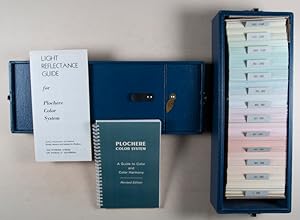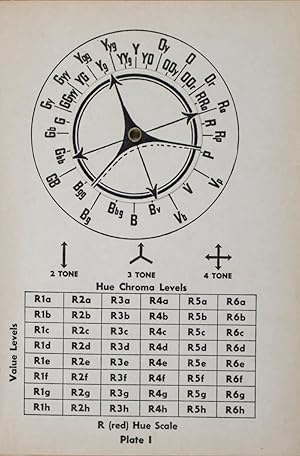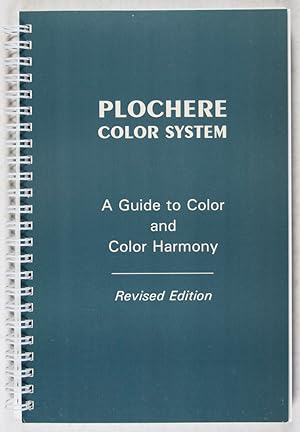Plochere, Gustave (3 results)
Product Type
- All Product Types
- Books (3)
- Magazines & Periodicals
- Comics
- Sheet Music
- Art, Prints & Posters
- Photographs
- Maps
-
Manuscripts &
Paper Collectibles
Condition
- All Conditions
- New
- Used
Binding
- All Bindings
- Hardcover
- Softcover
Collectible Attributes
- First Edition
- Signed
- Dust Jacket
- Seller-Supplied Images
- Not Printed On Demand
Seller Location
Seller Rating
-
Plochere Color System. A Guide to Color and Color Harmony. To be used in Conjunction with the 1248 Color Tone Cards Included in this Set
Published by Gladys and Gustave Plochere, Los Angeles, 1960
Seller: ERIC CHAIM KLINE, BOOKSELLER (ABAA ILAB), Santa Monica, CA, U.S.A.
Box. Condition: near fine. Later printing. With spiral-bound publication in lid compartment. Light blue box Blue leatherette box (4 1/2 x 17 x 6 1/2") with gilt lettering on cover, imitation leather handle, draw bolt latches and 1248 Color Tone Cards (3 x 5") with 116pp. spiral-bound guide with white lettering on cover warps, and Light Reflectance Guide housed in compartment of box. The book, 1992 revised edition by Eric Lutz, contains an introduction, abstracts on color terms, hue designation, color groupings, color harmonies, pigments, color names and a 24-hue color circle on card stock and an index of color names at rear. "The instructive chapters have been condensed and simplified, and the color information has been reformatted. Hue paint and to the advent of computerized color matching, mixing formulas for the colors in the Plochere Color System have also been eliminated. While the actual colors in the system have not been changed in any way, slight adjustments have been made to the hue designations, to the positioning of the hues on the color circle, and to the resultant color harmonies. The current color circle is no longer based directly on the Ostwald circle. While it retains some of the characteristics of the Ostwald arrangement (for example, a higher proportion of greens), it corresponds more closely with the conventional tripartite arrangement of yellow, magenta, and cyan." The Plochere Color Systemdeveloped by Gladys and Gustave Plochere was one of the first commercially available color systems with removable color cards in America preceding Munsell by several years. Since its introduction in 1948, it has served as a remarkably useful tool for color communication and specification for those in the fields of industry, education, and the arts. The goal was to systematize color so that all hues, tints, tones, and shades were compiled in a logical, thorough, and accessible manner. Starting in the 1940s until his death Plochere developed an illustrious circle of clients. Among them Joan Crawford, the fashion studio of Max Factor, the architects John Edward Lautner and Richard Neutra, the department stores Bullocks, Nordstrom, Sears-Roebuck, the paint companies Dunn-Edwards, Benjamin Moore and Ameritone, Disney Studios and Theme Parks, the Loew's Theater Chain, the National Broadcasting Company (NBC) and universities such as Stanford, M.I.T. and the University of California. Museums included the Metropolitan Museum of Art and the Huntington Library. The 1248 Color Tone Cards in leatherette box are compartmentalized by dividers with printed numbers 1-1248. All color cards with stamped numbers on verso. Complete.
-
Plochere Color System. A Guide to Color and Color Harmony. To be used in Conjunction with the 1248 Color Tone Cards plus 200 Gray tones Included in this Set
Published by Gladys and Gustave Plochere, Los Angeles, 1960
Seller: ERIC CHAIM KLINE, BOOKSELLER (ABAA ILAB), Santa Monica, CA, U.S.A.
Box. Condition: near fine. Later printing. With harback publication Licht Reflectance Guide in compartment. Light blue box. Blue leatherette box (4 1/2 x 18 x 6 1/2") with gilt lettering on cover, imitation leather handle, draw bolt latches and 1448 Color Tone Cards (3 x 5") with 199pp. black hardbound guide with white lettering on cover, and Light Reflectance Guide housed in compartment of box. The book, a 1946 third edition contains an introduction, an abstract on the color circle, color terms and their meaning, color harmony, directions for selecting color harmonies and the abbreviations used. "The instructive chapters have been condensed and simplified, and the color information has been reformatted. Hue paint and to the advent of computerized color matching, mixing formulas for the colors in the Plochere Color System have also been eliminated. While the actual colors in the system have not been changed in any way, slight adjustments have been made to the hue designations, to the positioning of the hues on the color circle, and to the resultant color harmonies. The current color circle is no longer based directly on the Ostwald circle. While it retains some of the characteristics of the Ostwald arrangement (for example, a higher proportion of greens), it corresponds more closely with the conventional tripartite arrangement of yellow, magenta, and cyan." The Plochere Color Systemdeveloped by Gladys and Gustave Plochere was one of the first commercially available color systems with removable color cards in America preceding Munsell by several years. Since its introduction in 1948, it has served as a remarkably useful tool for color communication and specification for those in the fields of industry, education, and the arts. The goal was to systematize color so that all hues, tints, tones, and shades were compiled in a logical, thorough, and accessible manner. Starting in the 1940s until his death Plochere developed an illustrious circle of clients. Among them Joan Crawford, the fashion studio of Max Factor, the architects John Edward Lautner and Richard Neutra, the department stores Bullocks, Nordstrom, Sears-Roebuck, the paint companies Dunn-Edwards, Benjamin Moore and Ameritone, Disney Studios and Theme Parks, the Loew's Theater Chain, the National Broadcasting Company (NBC) and universities such as Stanford, M.I.T. and the University of California. Museums included the Metropolitan Museum of Art and the Huntington Library. It is safe to say that the Plocheres functioned as importers and distributors of Paul Baumann's color system in the late 1920s. The "Baumann Color Guide/Prase" was first published in 1925 and copies of it were printed with the Plochere business address on its title page and some of Baumann's color card boxes also identify Plochere as the importer. The long-standing connection between Baumann and Plochere is important in as far as it can be seen as the basis and validation of Plochere's Color System. Baumann had carefully studied Ostwald's material after a dispute between the two during a conference of the German Crafts Association (Deutsche Werkbund) in 1915 and reported his findings to the Werkbund. Subsequently the Werkbund rejected Ostwald's system and sided with Baumann, so did the color industry, artists and the general consumer. The 1448 Color Tone Cards in leatherette box are compartmentalized by dividers with printed numbers 1-1248 and G1-200 for additional 200 grays. All color cards with stamped numbers on verso. Complete.
-
Plochere Color System. A Guide to Color and Color Harmony. To be used in Conjunction with the 1248 Color Tone Cards and 200 Gray tone Included in this Set
Published by Gladys and Gustave Plochere, Los Angeles, 1980
Seller: ERIC CHAIM KLINE, BOOKSELLER (ABAA ILAB), Santa Monica, CA, U.S.A.
Box. Condition: near fine. Later printing. Black leatherette box (5 x 18 x 6") with gilt lettering on cover, imitation leather handle, draw bolt latches and 1448 Color Tone Cards (3 x 5") with 116pp. spiral-bound guide with white lettering on cover warps, and Light Reflectance Guide housed in compartment of box. The book, 1992 revised edition by Eric Lutz, contains an introduction, abstracts on color terms, hue designation, color groupings, color harmonies, pigments, color names and a 24-hue color circle on card stock and an index of color names at rear. "The instructive chapters have been condensed and simplified, and the color information has been reformatted. Hue paint and to the advent of computerized color matching, mixing formulas for the colors in the Plochere Color System have also been eliminated. While the actual colors in the system have not been changed in any way, slight adjustments have been made to the hue designations, to the positioning of the hues on the color circle, and to the resultant color harmonies. The current color circle is no longer based directly on the Ostwald circle. While it retains some of the characteristics of the Ostwald arrangement (for example, a higher proportion of greens), it corresponds more closely with the conventional tripartite arrangement of yellow, magenta, and cyan." The Plochere Color Systemdeveloped by Gladys and Gustave Plochere was one of the first commercially available color systems with removable color cards in America preceding Munsell by several years. Since its introduction in 1948, it has served as a remarkably useful tool for color communication and specification for those in the fields of industry, education, and the arts. The goal was to systematize color so that all hues, tints, tones, and shades were compiled in a logical, thorough, and accessible manner. Starting in the 1940s until his death Plochere developed an illustrious circle of clients. Among them Joan Crawford, the fashion studio of Max Factor, the architects John Edward Lautner and Richard Neutra, the department stores Bullocks, Nordstrom, Sears-Roebuck, the paint companies Dunn-Edwards, Benjamin Moore and Ameritone, Disney Studios and Theme Parks, the Loew's Theater Chain, the National Broadcasting Company (NBC) and universities such as Stanford, M.I.T. and the University of California. Museums included the Metropolitan Museum of Art and the Huntington Library. The 1448 Color Tone Cards in leatherette box are compartmentalized by dividers with printed numbers 1-1248 and G1-200 for additional 200 grays. All color cards with stamped numbers on verso. Complete. Box and book in near fine condition.




